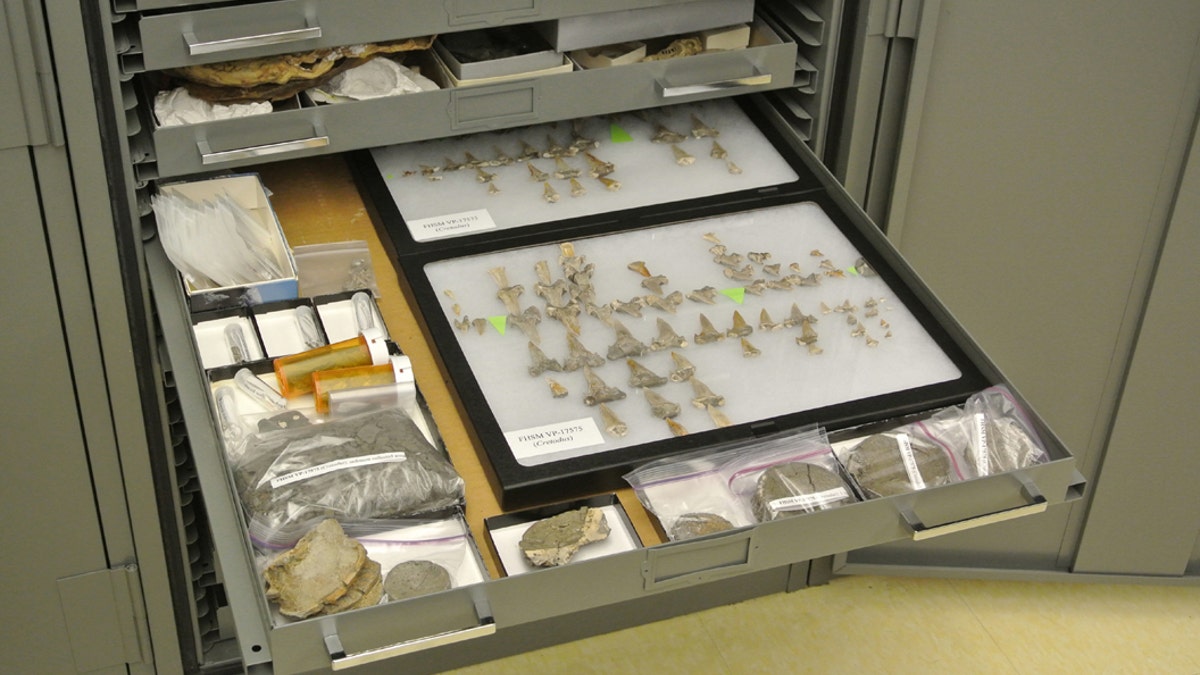Fox News Flash top headlines for Nov. 19
Fox News Flash top headlines for Nov. 19 are here. Check out what's clicking on Foxnews.com
The fossilized remains of a 91-million-year-old shark previously unknown to science have been discovered in Kansas, according to a new study.
Known as Cretodus houghtonorum, the remains were discovered in 2010 but were previously thought to belong to a different species of shark, Cretodus crassidens.
C. houghtonorum was likely 17 feet in length, based on the incomplete skeleton found. According to a growth model done by the researchers, it could have reached 22 feet in length. For comparison purposes, the average female great white shark is between 15 and 21 feet in length. The largest shark in history, the megalodon, reached up to 60 feet in length.

Close-up view of one of over 100 associated teeth of the newly described, 91-million-year-old fossil shark from Kansas, Cretodus houghtonorum. The extinct shark lived in the Western Interior Seaway that covered the middle of North America during the Late Cretaceous Period, the last part of the age of dinosaurs. (Credit: Kenshu Shimada/DePaul University and Sternberg Museum of Natural History)

3D rendering of an extinct Megalodon shark in the seas of the Cenozoic Era. (iStock)
MEGALODON TEETH DISCOVERED IN MEXICO
“Much of what we know about extinct sharks is based on isolated teeth, but an associated specimen representing a single shark individual like the one we describe provides a wealth of anatomical information that in turn offers better insights into its ecology,” said Kenshu Shimada, the lead author on the study, in the statement.
“As important ecological components in marine ecosystems, understanding about sharks in the past and present is critical to evaluate the roles they have played in their environments and biodiversity through time, and more importantly how they may affect the future marine ecosystem if they become extinct,” Shimada added.
The fossils discovered include 134 teeth, 61 vertebrae, 23 placoid scales and fragments of calcified cartilage, researchers said in a statement.
During the 2010 excavation, Shimada and Michael Everhart believed the fossil was C. crassidens, which was originally described from England and subsequently reported from North America. But when comparing the teeth of the new shark to that of C. crassidens, they realized "that almost all the teeth from North America previously reported as Cretodus crassidens belong to a different species new to science,” Shimada noted.

Pictured are teeth and other remains from a dinosaur-era shark fossil discovered in Kansas named Cretodus houghtonorum. (Credit: DePaul University/Kenshu Shimada)
A new species of shark would ordinarily be exciting enough, but the researchers also noted that given its "inferred large size at birth," it's possible it had intrauterine cannibalistic behavior as well.
370M-YEAR-OLD COMPLETE SHARK SKELETON FOUND FOR FIRST TIME EVER
“What is more exciting is its inferred large size at birth, almost 4 feet or 1.2 meters in length, suggesting that the cannibalistic behavior for nurturing embryos commonly observed within the uteri of modern female lamniforms must have already evolved by the Late Cretaceous period,” Shimada added.
The fossils of C. houghtonorum were also found with isolated teeth of another ancient shark, Squalicorax, as well as fragments of a hybodont shark, which Everheart believes may have been food for the larger predator.
“Circumstantially, we think the shark possibly fed on the much smaller hybodont and was in turn scavenged by Squalicorax after its death,” Everhart noted.
The research has been published in the Journal of Vertebrate Paleontology.





















